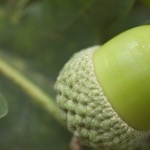
forestryengland.uk – 22-10-2020
This autumn is a bumper year for acorns and fruits across much of the nation’s forests.
Our oak trees have been producing a large crop of acorns this year, all because of one of nature’s mysterious events known as ‘masting’.
A bumper seed year is known as a ‘mast year’; a natural phenomenon where some tree species produce very large crops of seeds in some years, compared to very few seeds in others.
It’s not known exactly why mast years happen, however they have been linked to various causes over the years, including weather and climatic conditions.

Andrew Smith, Director of Westonbirt, The National Arboretum says:
“We experienced a warm and dry spring, which are the perfect conditions for flowers to ‘set’ seeds. This, along with no late frost meant that flowers and young fruit survived into summer. The warm and moist summer has meant the nuts, fruits and berries have filled out well and are continuing to ripen nicely.”
“Part of the fascination of experiencing a mast year is that we don’t completely understand the complex blend of factors that give rise to them and allow plants and trees to co-ordinate the production of so much fruit and seed. Weather and climate can certainly affect fruit and seed production in trees, however we also see certain trees go through cycles of mast years. For oak trees it’s usually every four years”
It's not just acorns that have experienced a bumper year, at Westonbirt, the National Arboretum trees such as hawthorn, Hupeh crab apple and mountain ash along with others have also seen a bumper year for fruits.



